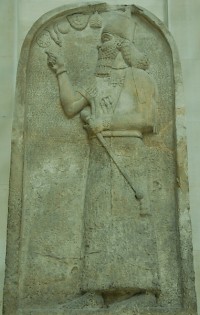Aššurnasirpal II's Expedition to the Lebanon
Tyre (Phoenician רצ, ṣūr, "rock"; Greek Τύρος; Latin Tyrus): port in Phoenicia and one of the main cities in the eastern Mediterranean.

King Aššurnasirpal II (r.883-859) managed to increase Assyrian power in the western countries. The expedition to the Lebanon and Amanus mountains is mentioned on annals that were written on the pavement slabs of the temple of Ninurta in Nimrud. The Tyrian king who offered tribute may have been Ithobaal I.
Many items are highly topical, like the cleaning of the weapons in the Mediterranean Sea, the sheep-offering, and the tribute. Still, the general gist is reliable: Aššurnasirpal had campaigned further to the west than was customary and had brought back the cedar wood the prove it.
This text, known as ANET3 276, was translated by Leo Oppenheim.
Aššurnasirpal II's Expedition to the Lebanon
[1] At that time, I seized the entire extent of the Lebanon Mountain and reached the Great Sea of the Amurru country. I cleaned my weapons in the deep sea and performed sheep-offering to the gods.
[2] The tribute of the seacoast - from the inhabitants of Tyre, Sidon, Byblos, Mahallata, Maiza, Kaiza, Amurru and Arvad (which is in the sea), gold, silver, tin, copper, copper containers, linen garments with multicolored trimmings, large and small monkeys, ebony, boxwood, ivory from walrus tusk - a product of the sea - their tribute I received and they embraced my feet.
[3] I ascended the mountains of the Amanus and cut down logs of cedars, stone pines, cypresses, and pines, performed sheep-offerings to my gods. I had made a sculptured stela commemorating my heroic achievements and erected it there.
[4] The cedar beams from the Amanus mountain I sent to the temple of Esarra for the building of a iasmaku-sanctuary as a building for festivals serving the temples of Sin and Šamaš, the light-giving gods.note